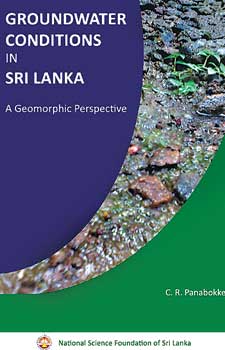
Reservoir of data on our water resourcesBook facts: Groundwater Conditions in Sri Lanka –a Geomorphic Perspective by C.R. Panabokke. Published by the National Science Foundation of Sri Lanka. 2008. 150 pages. The book is timely because we are already in the 21st century, for which water promises to be what oil was to the 20th century: the precious commodity that determines the wealth of nations. As modern-day humanity continues to extract, deplete and pollute water, we are creating a looming problem of water scarcity. Groundwater is being viewed as a possible answer. This easy-to-read book sheds light on the nature and character of the resource, and the precautions necessary when tapping groundwater. Chapter I offers a general introduction to groundwater, and also refers to the controversial subject of water divining, a mystery that modern science is still trying to explain. The next chapter provides general information and data relating to organisations and institutions concerned with groundwater as a resource.
Chapter III provides an island-wide view of the country’s groundwater capacities. Sri Lanka is revealed as a hydrogeological paradise, and highly suitable as a learning laboratory for tropical groundwater studies. The writer points to the rapid decline in the groundwater table in neighbouring Tamil Nadu, India, as a result of deep well tapping, as a warning signal for Sri Lanka. Groundwater in the Jaffna peninsula is discussed in detail. Jaffna represents the country’s most successful example of intensive farming with groundwater. The northwest coastal plain has substantial groundwater resources, with high potential for tapping for agricultural purposes. Chapter VI focuses on the biggest single land area in the country. Here, an impervious rock base almost completely stops rain-derived water from percolating below; this water is held in the regolith and overburden (disintegrated and decomposed mineral and organic matter occurring naturally on the surface of the earth). The regolith water table fluctuates between wet and dry seasons; the response to rainfall takes time because soil saturation consumes about 170mm of cumulative rain before the water table can rise. All this helps the reader to understand the land use and land settlement patterns that prevail in the area. Chapter VII looks at the shallow aquifers in unconsolidated coastal sands, showing how rain-derived fresh water delicately rests on the heavy saline water. Alluvial aquifers are found islandwide. Chapter X is best read alongside Chapter VI because both focus on the same basement rock type. The wet zone is wetter and higher in relief; its regolith aquifer richer and emergent at slope break points, better enabling settlement and farming. Chapter XI shows groundwater surfaces as springs or free water. Badulla district has the largest number of springs (“ula” is a local term for spring). Chapter XII discusses sustainability in groundwater management and lists measures to provide for resource stewardship. The writer shows how water decline can have a serious impact on water quality and the environment, and points to cases of over-extraction by an excess of agro-wells, especially in the Anuradhapura district. Safety precautions recommended include reducing extraction, regular monitoring and avoiding over-fertilization of farms, especially with nitrate generating fertilizer/manure. The book is a masterly synthesis of a multitude of documents written by a variety of authors over more than half a century. The writer is to be commended for his scientific clarity, professional excellence, broad experience and intimate understanding of his subject. Sri Lanka is blessed with substantial rain, and this rain is the primary source of our groundwater. (The reviewer is a former Senior Scientist, Department of Agriculture) |
|
||||||
|| Front
Page | News | Editorial | Columns | Sports | Plus | Financial
Times | International | Mirror | TV
Times | Funday
Times || |
| |
Reproduction of articles permitted when used without any alterations to contents and a link to the source page.
|
© Copyright
2008 | Wijeya
Newspapers Ltd.Colombo. Sri Lanka. All Rights Reserved. |
